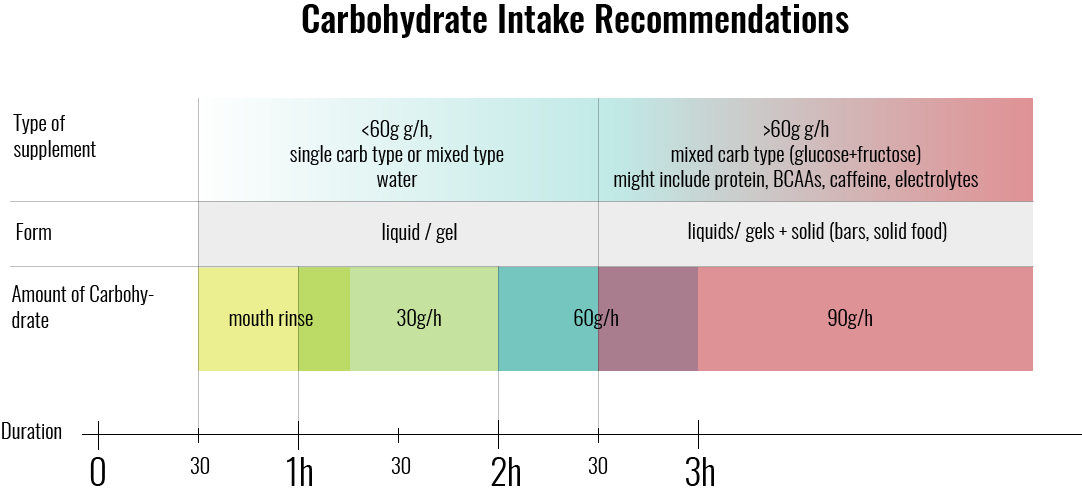If you follow any athlete on social media, you will find that they use different nutrition, gels, bars, powder that mixes with water.
So what is the actual difference between those products? Isn’t there a recommendation to follow? Yes, there is general recommendation, which is a good starting point but let me tell you that everybody is different and therefore needs a personalized race-nutrition plan.
To begin with, let’s discuss the benefits of carbohydrate intake during exercise.
Functions of intra-workout nutrition:
- provides energy for a quality workout;
- prevents injuries;
- helps with recovery;
- prevents unwanted muscle loss;
- a low carbohydrate state is likely to compromise endurance performance while intake of carbohydrates during activity increases endurance performance [4][6]
- Individual differences in how much carbs you can handle during an activity – it can be trained.
- Physical limitations – We are limited by the number of transporters that transport simple sugars. It does not matter how much you intake, important is how much you can absorb/oxidize.
- Intensity of the activity – Our digestion works best when we are at rest. When we put ourselves in an acute stress, such as competition or an exercise, our hormones slow down our digestion.
Tip: Check the next time the label of your favourite energy gel if it uses different sources of carbohydrates.
I don’t need to go far to see that there are a huge differences in how much carbs can athletes tolerate. Often, people state things like they cannot train or go hard with anything in their stomach. This was the first limitation I mentioned in the beginning of this article.
It is not necessary for everyone though to drink or eat during a race. We don’t see sprinters do that 😉 Activities shorter than 60 minutes don’t require an exogenous (eating/drinking) glucose intake. A simple carbohydrate mouth rinse is more than enough considering you already had a meal that day and it is not a second training session.
But with the increasing time, it might be wise to start using nutrition during your race or workout. Different intensities and duration of activity dictates the recommended dose of carbohydrates for performance. The main goal of an performance athlete is to find the dose that supports his or her best effort without upsetting stomach.
The Types of Sugar
There are several types of sugar as hinted above and you want to leverage it! But besides using different types because of different transporters, I also thought about the GI of foods, i.e. how was the sugars are spiked in the blood and the insulin response.
Glyacemic Index
When it comes to sports, we should not be afraid of high GI foods. Quite contrary! These spikes of insulin can help us by providing fast energy and replenish glycogen stores faster after a race or a workout. Since I am using whole foods, the GI is not very high, but it is sustainable, which means no high insulin spikes, but rather a steady energy release.
Fiber Content
Fiber is not something you’d find in a store-bought energy gel but it is part of any whole-food based gel. It also plays a role in energy release. The higher the fiber content, the slower and more steady release of energy you can expect.

By using a combination of carbohydrates that use different intestinal transporters for absorption it was shown that carbohydrate delivery and oxidation could be increased. Studies demonstrated increases in exogenous carbohydrate oxidation rates of up to 65% of glucose: fructose compared with glucose only. [4]
We are limited by the number of transporters available for transport of sugars. Glucose absorption is limited to 60g/h and fructose to 30g+/h. [3]
The faster carbohydrates include glucose (grape sugar), sucrose (table sugar), maltose (milk sugar), maltodextrins, starches. Carbohydrates that are slower are fructose (typically found in high doses in fruit), galactose, trehalose and some starches (those that are not very well soluble in water).
If fructose is ingested at high rates (and it is not ingested with another carbohydrate), it is known to result in gastro-intestinal discomfort. Also, any undigested food and liquid will result in the same problem. That’s why athletes use longer training sessions to test they race nutrition.
Training Your Gut
Some people avoid carbohydrate intake during or even short time before a vigorous activity. Often, it is because they cannot handle training and racing with any content in their stomach.
This is one of the ways we differ person to person. There are athletes who can easily handle the amount of carbs or don’t mind training and racing with them. Their digestion also seems to be naturally better.
Fortunately, if you don’t handle carbs well, you can train your gut.
Here are some of the ways how to train your gut: [2]
- Training on full stomach.
- Training with your race nutrition.
- Increasing your carbohydrate intake in your diet, which upregulates the carbohydrate ingestion and oxidation.
It was demonstrated that exogenous carbohydrate oxidation rates were higher after the high-carbohydrate diet (6.5 g/kg BW/day; 1.5 g/kg BW provided mainly as a carbohydrate supplement during training) for 28 days compared with a control diet (5 g/kg BW/day). [1]
A word on high fat diets
As a result of people not being able to handle intra-workout nutrition, some people started speculating that with the amount of fat we carry we could have enough energy to sustain any event with fat oxidation provided by our fat stores.
While it is good to train your body to be able to use fat as a fuel source effectively, we don’t want to rely on it as a sole source of fuel. High fat diets up-regulate our capacity to use fat as a fuel, however they also down-regulate our capacity to use glucose. Therefore, entering an event and thinking you could use your fat stores together with gels effectively might result in GI issues leading you to believe it was a bad thing to use that sugar-loaded energy gel.
The same principle applies to the high-carb diets.
However, we can train our metabolism to use both systems and sources effectively through training and nutrition.
A real life example
People who start running for weight-loss often do this mistake. They go for a run and run too hard during their easy days and too easy during their performance days (if they even have this variety in the first place).
After the run they are hungry and eat even more than they burnt. It is not rare to see people who train for marathons actually gain weight!
I noticed this especially applies when people run on empty stomach in the morning, or when they do a long run without nutrition because they feel like they can’t eat before nor during the run.
For your easy runs, slow down. You will train your body to burn more fat during the activity. It can adequately fuel your long-runs if you don’t go too hard.
But for harder workouts and races, I advise you to train your gut to handle gels, energy bars and water. It will prevent post-exercise cravings and provide you with energy for your workouts.
Not everybody is the same and some people need more gut training than the other. Neither can everybody intake the same amount of food and you might need some time to find how much and what type of energy you can handle.
Nicole, who trains for marathon might do her run first thing in the morning. If the run is below 60 minutes, she might want to grab a bottle of water and maybe an energy gel on the side or a banana or any other fruit.
After the run she has a breakfast.
On the days that she has harder workouts such as tempo sessions, she might want to grab a gel or two. She can handle the 30 minutes tempo run (plus 20 minutes warm up and 20 minutes cool down) without problems even without any energy gels, but later that day, she feels like ravenous hunger. That leads her to gain weight despite her training. When she has a gel or two (~240 kcal altogether), she does not feel ravenously hungry after the training and doesn’t overeat and her body composition improves.
Besides that, the gels help with the second meal effect, which help her body to be more sensitive to insulin (on top of exercise), lowering the spike with the first meal.
Energy Gel - Go Intense!
- Periodized Nutrition for Athletes, Jeukendrup, A.E. Sports Med (2017) 47(Suppl 1): 51. https://doi.org/10.1007/s40279-017-0694-2
- Training the Gut for Athletes, Jeukendrup, A.E. Sports Med (2017) 47(Suppl 1): 101. https://doi.org/10.1007/s40279-017-0690-6
- A Step Towards Personalized Sports Nutrition: Carbohydrate Intake During Exercise, Jeukendrup, A. Sports Med (2014) 44(Suppl 1): 25. https://doi.org/10.1007/s40279-014-0148-z
- Carbohydrate and exercise performance: the role of multiple transportable carbohydrates, Current Opinion in Clinical Nutrition and Metabolic Care. 13(4):452–457, JUL 2010, DOI: 10.1097/MCO.0b013e328339de9f, https://insights.ovid.com/pubmed?pmid=20574242
- Nutritional intake and gastrointestinal problems during competitive endurance events., Medicine & Science in Sports & Exercise. 44(2):344–351, FEB 2012, DOI: 10.1249/MSS.0b013e31822dc809, PMID: 21775906
